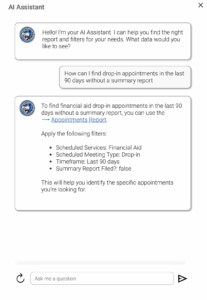6 barriers to enrollment community college students face
Community colleges have always been a lifeline for students seeking opportunities, skills, and a better future. But today, the path from inquiry to enrollment is not as straightforward as it once was. For too many prospective students, the admissions and onboarding process feels confusing, and they may not be getting the personal attention they want.
Part of this is because, behind the scenes, admissions and recruitment teams are feeling overwhelmed. Applicant-to-staff ratios can exceed 1,000 to 1, and thousands of college staff are just plain burned out. Prospective students expect personalized, rapid responses, often within hours, yet manual processes and overflowing inboxes make it nearly impossible to keep up.
EAB’s latest survey of 1,000+ community college students offers an unfiltered look at where prospective students face the most friction and how those pain points can push them to opt out entirely. The good news is that these challenges are solvable. By combining human connection with AI-powered tools, colleges can create a smoother, more supportive path to enrollment.
Six Enrollment Insights From 1,000 Community College Students:
1. Students Want More Personal Interactions
When asked directly, 73% of students rated personal interaction during onboarding as extremely or very important. This is not just a preference; it could be a deciding factor in a student’s choice between your college and a competitor. Before applying, many students sought face-to-face engagement: 27% toured campus, 23% attended an on-campus information session, and 21% joined a high school information session hosted by the college.
Yet for many admissions teams, time spent answering emails and fielding phone calls leaves little room for these connections. It also means teams need systematic, easy ways to follow up with students who are seeking out those on-campus experiences.
Solution: Assess what manual processes take up the most time, like answering emails, responding to information request forms, and updating spreadsheets. Consider process mapping your onboarding experience to understand what is taking time away from personal interactions with students, and then consider how an AI-powered CRM like Navigate360 can streamline your admissions workflow with built-in automations, student-facing Knowledge Agents, plain language report builders, and more.
-
Did you know?
Navigate360’s Recruitment Success CRM makes it easy to track, communicate with, and onboard prospective students? Learn more here.
2. Staff Are Stretched Thin by Manual Information Requests
When students request information, email (45%) and phone (36%) remain the most common channels. While effective, they demand significant staff time, especially when the same questions come up again and again. Although nearly 60% of Gen Z are open to using AI for customer service, only 28% reported using a chatbot or live chat option when contacting their college. This gap suggests that many colleges have not invested in robust self-service tools or have not effectively promoted them to students.
Anyone who’s worked on campus knows that email and phone call whack-a-mole is frustrating for both students and staff, especially when both parties want more opportunities to solve complex problems one-on-one.
Solution: Navigate360’s AI Knowledge Agent can act as the first point of contact 24/7, answering FAQs, helping students schedule appointments, and delivering personalized next steps. The agent can respond to students in over 90 different languages, ensuring that all students receive the help they need.
4 Ways AI Can Freeze Summer Melt at Community Colleges
3. Students Expect Faster Responses
Imagine that you sent an email to a contractor, a doctor’s office, your child’s school, or your mechanic, and think about when you would expect a response back. I think most of us would say within 24 hours, and none of us would want to wait more than a week. Students are the same: 73% expect a response to their questions within 24 hours, yet only 21% receive one within 24 hours. For 27%, it took more than a week to hear back, and 7% never received a reply at all.
You can imagine how, for a first-generation student balancing a job, family responsibilities, and college planning, waiting a week for a simple answer about financial aid can mean choosing another school or giving up altogether.
Solution: AI-assisted content tools, like Navigate360’s Content Creation Agent, can generate personalized, relevant emails in seconds. When combined with an integrated CRM with automation capabilities, staff can respond faster without sacrificing quality. At Central Virginia Community College, automating outreach allowed staff to manage up to 1,000 prospects in the time it once took to handle five, resulting in a 56% inquiry-to-application yield.
Insight Paper: Break Through the Enrollment Bottleneck
4. Many Students Are One Obstacle Away from Opting Out
In our survey, over half of the students, 56%, said they considered not enrolling at all. What’s important about this is examining why and determining which barriers colleges can control and respond to, so more students who are on the fence realize that college is within reach.
When we asked why, the answers were telling. Almost one in four (22%) said they were frustrated by the enrollment process itself. Many shared big picture worries that caused them to question enrolling in college altogether: choosing a major (24 percent), figuring out how to pay (19%), juggling work or family obligations (23%), or even doubting whether they would belong in college at all (18%). These are all barriers that colleges can proactively respond to by understanding more about their prospective student base and highlighting supports, services, and enrollment options (like attending part-time).
Solution: The key to catching these pain points before they push students away is having robust information request forms, applications, and onboarding surveys. Navigate360’s Recruitment Success CRM helps capture prospective student information so your team can create AI-powered custom outreach plans.
5. Students Need More Guidance Choosing a Major
Choosing a major is one of the most confusing onboarding steps for 23% of students, and one in five said they did not get enough help making that choice. When asked why they thought about opting out of college, the top reason was that a staggering 24% said they were unsure what to major in. Choosing the right-fit major is critical to keeping students engaged in their coursework. At the same time, with growing skepticism about the value of a college degree, it’s understandable that students want to feel confident they are making the right choice for their future careers.
Solution: Navigate360’s AI Course Planning Agent can help students explore potential schedules to prepare for their academic advising appointments. This allows advisors to focus on deeper conversations about career decisions, employment, strengths, and interests, helping students find the “right fit” program they are looking for.
6. Onboarding Overserves Some Students and Underserves Others
Every student enters college with unique needs during the onboarding process. Some feel comfortable navigating forms, placement testing, and advising on their own, while others require detailed step-by-step guidance. When institutions treat all students the same by sending identical instructions, reminders, and outreach, they risk missing opportunities to connect more deeply with those who need additional support. At the same time, they may devote unnecessary time to students who are already managing well.
How would you rank the amount of personalized support you received during each one of these interactions when you first enrolled at the college? N=1,001

Our research shows the divide clearly: on average, around 20% of students reported they needed more support with enrollment tasks, while another 22% said they received too much. The challenge, then, is determining how to strike a better balance between students who need more from us and students who need less.
Solution: Navigate360’s AI Report Agent allows admissions teams to find and create data reports instantly, using plain language, so teams can pinpoint students who are “stuck” in the onboarding funnel, so staff can delegate more time to them.

Key Takeaways for Community College Leaders
- The competition for students will intensify while staffing levels remain the same.
- Staff need relief from routine administrative tasks so they can focus on student engagement and strategic initiatives.
- Students expect speed, personalization, and clear guidance, and they make enrollment decisions based on whether they receive it.
- AI tools can create capacity, improve responsiveness, and make the enrollment experience more human.
The enrollment journey is more than a transaction. It is the moment when a student decides whether they see themselves belonging at your college. By pairing the personal commitment of your staff with the efficiency of AI, you can turn that moment into a powerful beginning for every student.

More Blogs

The opportunity gap undermining your enrollment strategy

What enrollment leaders can learn from Alabama’s statewide direct admissions program
